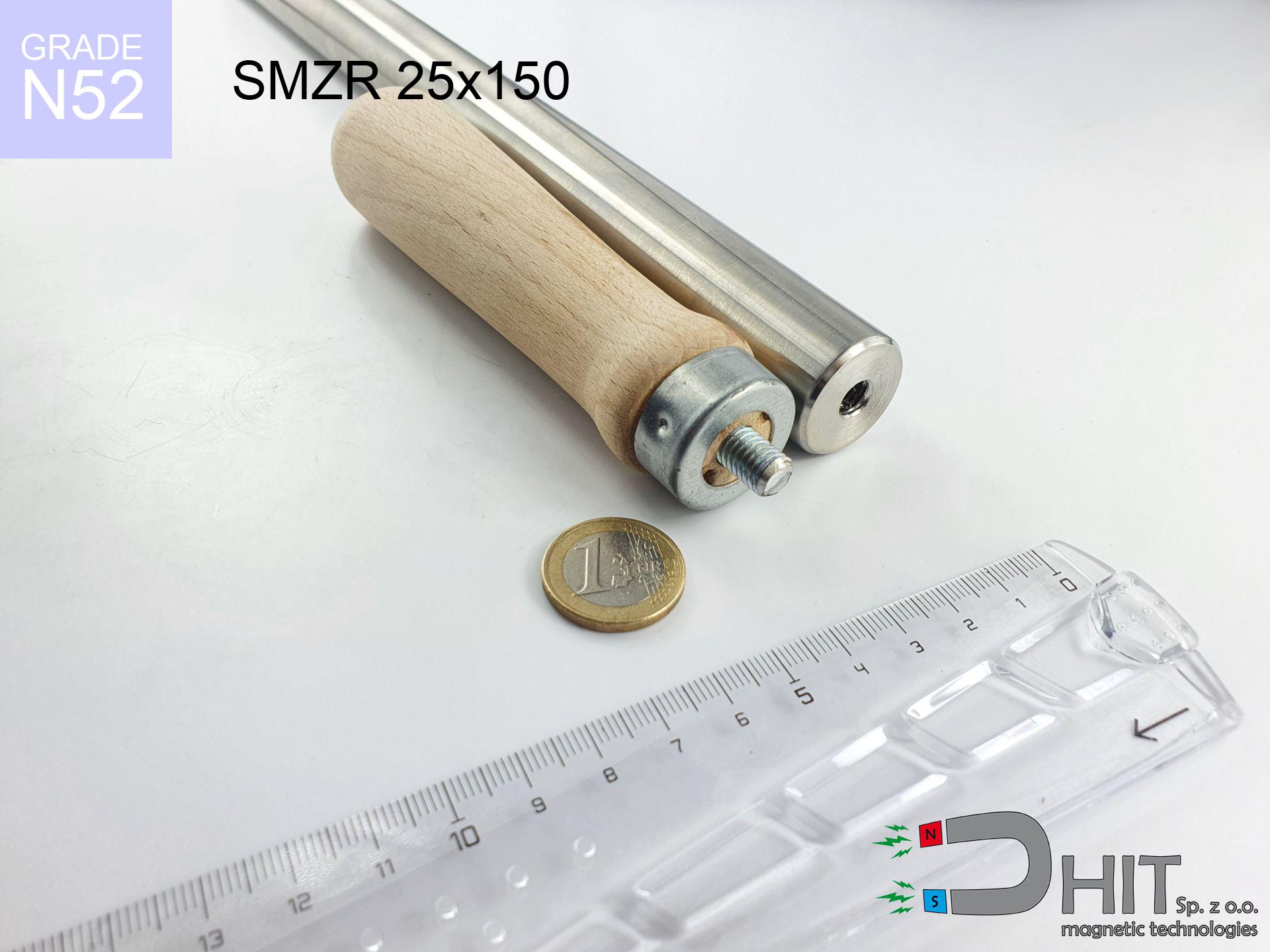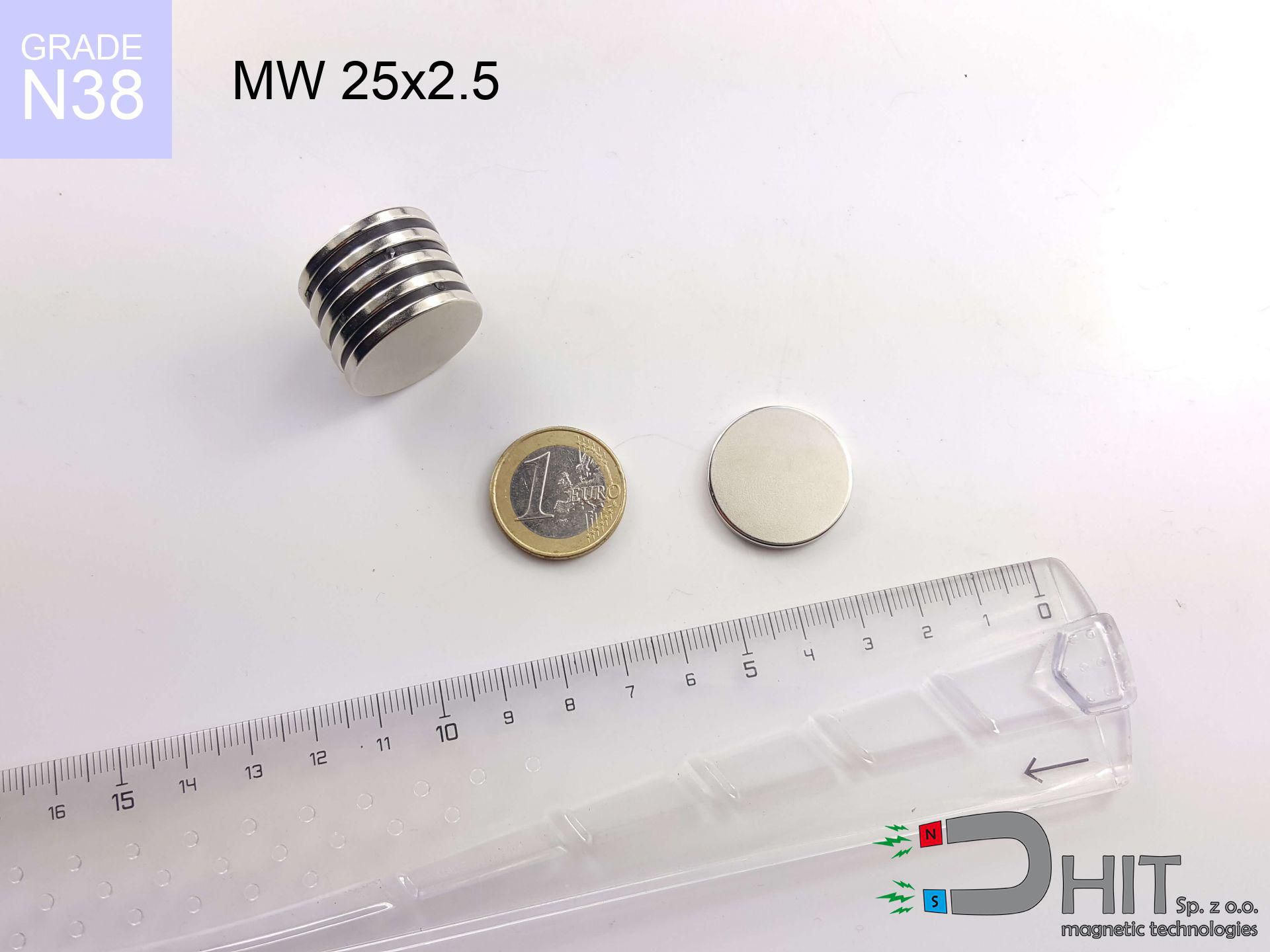SMZR 25x150 / N52 - magnetic separator with handle
magnetic separator with handle
Catalog no 140234
GTIN/EAN: 5906301813422
Diameter Ø
25 mm [±1 mm]
Height
150 mm [±1 mm]
Weight
640 g
Magnetic Flux
~ 8 500 Gauss [±5%]
430.50 ZŁ with VAT / pcs + price for transport
350.00 ZŁ net + 23% VAT / pcs
bulk discounts:
Need more?
Pick up the phone and ask
+48 888 99 98 98
or send us a note using
contact form
the contact page.
Parameters along with structure of a neodymium magnet can be analyzed with our
modular calculator.
Order by 14:00 and we’ll ship today!
Technical details - SMZR 25x150 / N52 - magnetic separator with handle
Specification / characteristics - SMZR 25x150 / N52 - magnetic separator with handle
| properties | values |
|---|---|
| Cat. no. | 140234 |
| GTIN/EAN | 5906301813422 |
| Production/Distribution | Dhit sp. z o.o. |
| Country of origin | Poland / China / Germany |
| Customs code | 85059029 |
| Diameter Ø | 25 mm [±1 mm] |
| Height | 150 mm [±1 mm] |
| Weight | 640 g |
| Material Type | Stainless steel AISI 304 / A2 |
| Magnetic Flux | ~ 8 500 Gauss [±5%] |
| Size/Mount Quantity | M8x2 |
| Polarity | circumferential - 5 poles |
| Casing Tube Thickness | 1 mm |
| Manufacturing Tolerance | ±1 mm |
Magnetic properties of material N52
| properties | values | units |
|---|---|---|
| remenance Br [min. - max.] ? | 14.2-14.7 | kGs |
| remenance Br [min. - max.] ? | 1420-1470 | mT |
| coercivity bHc ? | 10.8-12.5 | kOe |
| coercivity bHc ? | 860-995 | kA/m |
| actual internal force iHc | ≥ 12 | kOe |
| actual internal force iHc | ≥ 955 | kA/m |
| energy density [min. - max.] ? | 48-53 | BH max MGOe |
| energy density [min. - max.] ? | 380-422 | BH max KJ/m |
| max. temperature ? | ≤ 80 | °C |
Physical properties of sintered neodymium magnets Nd2Fe14B at 20°C
| properties | values | units |
|---|---|---|
| Vickers hardness | ≥550 | Hv |
| Density | ≥7.4 | g/cm3 |
| Curie Temperature TC | 312 - 380 | °C |
| Curie Temperature TF | 593 - 716 | °F |
| Specific resistance | 150 | μΩ⋅cm |
| Bending strength | 250 | MPa |
| Compressive strength | 1000~1100 | MPa |
| Thermal expansion parallel (∥) to orientation (M) | (3-4) x 10-6 | °C-1 |
| Thermal expansion perpendicular (⊥) to orientation (M) | -(1-3) x 10-6 | °C-1 |
| Young's modulus | 1.7 x 104 | kg/mm² |
Table 1: Rod construction
SMZR 25x150 / N52
| Parameter | Value | Description / Unit |
|---|---|---|
| Diameter (Ø) | 25 | mm |
| Total length | 150 | mm (L) |
| Active length | 130 | mm |
| Section count | 5 | modules |
| Dead zone | 20 | mm (Blaszka 2mm + Gwint 18mm) |
| Weight (est.) | ~560 | g |
| Active area | 102 | cm² (Area) |
| Housing material | AISI 304 | 1.4301 (Inox) |
| Surface finish | Ra < 0.8 µm | Polished |
| Temp. class | 80°C | Standard (N) |
| Force loss (at max °C) | -12.8% | Reversible loss (physics) |
| Force (calculated) | 18.1 | kg (theor.) |
| Induction (surface) | ~8 500 | Gauss (Max) |
Chart 2: Field profile (5 sections)
Chart 3: Temperature performance
Chemical composition
| iron (Fe) | 64% – 68% |
| neodymium (Nd) | 29% – 32% |
| boron (B) | 1.1% – 1.2% |
| dysprosium (Dy) | 0.5% – 2.0% |
| coating (Ni-Cu-Ni) | < 0.05% |
Ecology and recycling (GPSR)
| recyclability (EoL) | 100% |
| recycled raw materials | ~10% (pre-cons) |
| carbon footprint | low / zredukowany |
| waste code (EWC) | 16 02 16 |
View also proposals
Pros and cons of Nd2Fe14B magnets.
Strengths
- They retain attractive force for around ten years – the loss is just ~1% (according to analyses),
- Magnets very well resist against demagnetization caused by foreign field sources,
- The use of an shiny finish of noble metals (nickel, gold, silver) causes the element to look better,
- Neodymium magnets ensure maximum magnetic induction on a their surface, which increases force concentration,
- Neodymium magnets are characterized by extremely high magnetic induction on the magnet surface and can work (depending on the form) even at a temperature of 230°C or more...
- Possibility of individual machining as well as modifying to individual requirements,
- Huge importance in advanced technology sectors – they are utilized in HDD drives, electric drive systems, diagnostic systems, also modern systems.
- Compactness – despite small sizes they offer powerful magnetic field, making them ideal for precision applications
Weaknesses
- At strong impacts they can crack, therefore we advise placing them in steel cases. A metal housing provides additional protection against damage and increases the magnet's durability.
- Neodymium magnets demagnetize when exposed to high temperatures. After reaching 80°C, many of them experience permanent drop of strength (a factor is the shape as well as dimensions of the magnet). We offer magnets specially adapted to work at temperatures up to 230°C marked [AH], which are extremely resistant to heat
- Magnets exposed to a humid environment can rust. Therefore during using outdoors, we advise using waterproof magnets made of rubber, plastic or other material resistant to moisture
- Limited ability of making nuts in the magnet and complex shapes - recommended is casing - magnet mounting.
- Potential hazard resulting from small fragments of magnets pose a threat, when accidentally swallowed, which becomes key in the aspect of protecting the youngest. Additionally, tiny parts of these products are able to complicate diagnosis medical when they are in the body.
- Higher cost of purchase is one of the disadvantages compared to ceramic magnets, especially in budget applications
Lifting parameters
Best holding force of the magnet in ideal parameters – what contributes to it?
- on a base made of structural steel, effectively closing the magnetic flux
- possessing a thickness of min. 10 mm to ensure full flux closure
- with a plane free of scratches
- without any clearance between the magnet and steel
- during pulling in a direction vertical to the mounting surface
- at standard ambient temperature
What influences lifting capacity in practice
- Air gap (between the magnet and the metal), because even a very small clearance (e.g. 0.5 mm) results in a reduction in lifting capacity by up to 50% (this also applies to paint, rust or dirt).
- Loading method – declared lifting capacity refers to pulling vertically. When slipping, the magnet exhibits much less (often approx. 20-30% of maximum force).
- Metal thickness – thin material does not allow full use of the magnet. Part of the magnetic field penetrates through instead of generating force.
- Steel type – mild steel attracts best. Alloy steels decrease magnetic properties and holding force.
- Plate texture – ground elements guarantee perfect abutment, which increases force. Uneven metal reduce efficiency.
- Heat – NdFeB sinters have a negative temperature coefficient. When it is hot they are weaker, and in frost they can be stronger (up to a certain limit).
Lifting capacity testing was performed on a smooth plate of suitable thickness, under perpendicular forces, in contrast under shearing force the holding force is lower. Moreover, even a small distance between the magnet and the plate decreases the holding force.
Precautions when working with neodymium magnets
Do not underestimate power
Exercise caution. Neodymium magnets attract from a long distance and connect with massive power, often quicker than you can react.
Permanent damage
Monitor thermal conditions. Heating the magnet above 80 degrees Celsius will ruin its magnetic structure and pulling force.
Choking Hazard
These products are not toys. Accidental ingestion of a few magnets may result in them connecting inside the digestive tract, which poses a severe health hazard and necessitates immediate surgery.
Flammability
Fire warning: Rare earth powder is highly flammable. Do not process magnets in home conditions as this may cause fire.
Fragile material
Neodymium magnets are sintered ceramics, meaning they are prone to chipping. Collision of two magnets leads to them cracking into small pieces.
Electronic hazard
Do not bring magnets near a wallet, laptop, or screen. The magnetic field can destroy these devices and wipe information from cards.
Warning for heart patients
Warning for patients: Powerful magnets affect medical devices. Keep minimum 30 cm distance or request help to handle the magnets.
Keep away from electronics
Remember: neodymium magnets generate a field that disrupts precision electronics. Maintain a separation from your phone, device, and GPS.
Bone fractures
Protect your hands. Two large magnets will join instantly with a force of massive weight, destroying everything in their path. Exercise extreme caution!
Nickel coating and allergies
Warning for allergy sufferers: The nickel-copper-nickel coating contains nickel. If an allergic reaction occurs, cease handling magnets and use protective gear.





![SM 32x425 [2xM8] / N42 - magnetic separator SM 32x425 [2xM8] / N42 - magnetic separator](https://cdn3.dhit.pl/graphics/products/sm-32x425-2xm8-woj.jpg)


